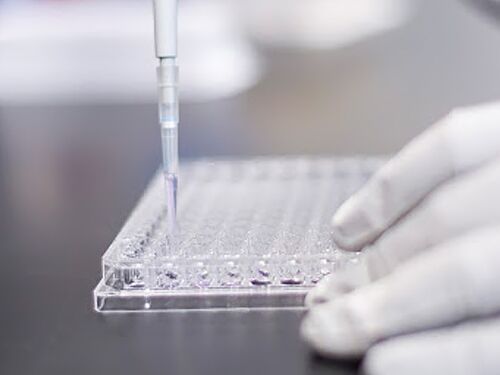Protecting Human Health through Biotechnology Breakthroughs and Platforms
Perspectives
By guest contributor Noubar Afeyan
Last update May 25, 2021
Photo credit: Moderna

NAE Perspectives offer practitioners, scholars, and policy leaders a platform to comment on developments and issues relating to engineering.
Noubar Afeyan is founder and CEO of Flagship Pioneering, and cofounder and chairman of Moderna.
On November 15, 2020, after 4 months in large-scale Phase 3 clinical testing, Moderna received resounding proof that its new class of medicines based on messenger RNA encased in lipid nanoparticles could be safely deployed as a highly effective vaccine to combat the covid-19 pandemic. After nearly 10 years of development and testing, this biotechnology breakthrough became the core of a new life science platform with therapeutic applications for many diverse diseases.
For an industry generally characterized by low probabilities of success and long timelines, how did this approach succeed on its first try against the SARS-CoV-2 virus, and in record time? What can be learned from this experience and how can it enable more effective, preemptive interventions to health threats?
* *
For more than a quarter century, the vast majority of medicines used to treat or prevent disease came in one of two forms: small molecules or proteins. While DNA, short RNA, viruses, bacteria, and even human cells are all under active scientific and clinical development, their uses have been limited by various technical challenges to their safety, efficacy, or manufacturability. Alongside these alternatives, messenger RNA (mRNA) had also been considered for over 2 decades, but the adverse immune response caused by exogenous mRNA introduced into mammalian cells rendered those efforts unsuccessful.
By 2010 experiments in two academic labs (at the University of Pennsylvania[1] and Harvard University[2]) had shown that mRNA with certain chemical modifications could be translated more efficiently into an encoded protein with lower adverse immune response. These findings led my colleagues and me to initiate a project we named LS18 (the 18th such scientific platform undertaken by Flagship Pioneering and the precursor to what became Moderna). Our aim? To invent the necessary chemical modifications, in vivo delivery technologies, mRNA design and optimization software, and automated fabrication and large-scale manufacturing process needed to render mRNA into a class of new human medicines.
Moderna spent the past decade combining bioengineering, chemical engineering, and systems engineering advances to create its mRNA platform and a large development pipeline of 24 mRNA-based therapeutics and vaccines. Many engineering advances and inventions were enabling to our technology, including the computational design of mRNA constructs for in vivo expression, automated systems to produce thousands of different mRNAs, purification and analysis technologies for this new class of molecules, the process for GMP manufacturing of lipid nanoparticle–encased mRNA, and the overall systems needed to go from sequence to product efficiently.
Despite the progress and over $2 billion spent, mRNA had still not yet been approved for use as a human medicine by early 2020. Covid-19 changed that almost overnight. Beginning in late January 2020 and at the urging of public health officials and scientists tracking the alarming spread of a mysterious virus, Moderna’s platform was put to use to design, fabricate, test, and scale up the production of mRNA-1273, the first vaccine against the SARS-CoV-2 pandemic virus to enter human trials. By leveraging the decade of platform development as well as an ongoing partnership between scientists at Moderna and the National Institutes of Health (NIH)’s National Institute of Allergy and Infectious Disease (NIAID), the company was able to design the mRNA vaccine 2 days after receiving the viral RNA code, produce and test small quantities during the following weeks, and deliver the vaccine to the NIH for the start of Phase 1 trials on human subjects within 42 days of sequence selection.
This speed and precision of vaccine design and production represented a significant performance leap compared to prior vaccine technologies. Nine months later, and after extensive Phase 3 testing in a diverse cohort of 30,000 subjects, the Moderna vaccine showed 94 percent efficacy and no severe adverse effects. The FDA authorized it for emergency use on December 18, 2020. To date more than 115 million doses have been administered in the United States.
What can we learn from this experience?
It is still quite early to draw all the lessons, but four observations about the past year may be worth considering.
First, when platform development precedes product development, the potential benefits are enormous. Although mRNA had not been used previously as a human medicine, there was an enormous body of platform development and research, without which the probability of success and immunological performance would not have been possible, especially at lightning speeds. Many of the advances made by the company were described in a large number of patent filings, enabling others to rapidly employ mRNA technology in their own covid-19 vaccine development efforts. To accelerate efforts to make and deploy vaccines across the globe, Moderna announced in October 2020 that it would not enforce its patents on mRNA vaccine technology during the pandemic period, allowing others to benefit from our decade of experimentation and refinement.
Second, information molecules hold the promise of reimagining medicine as we know it. As a code molecule, mRNA represents a completely novel class of medicines. An essential part of the flow of information from its stored form in cells (DNA) to the structurally and functionally active form (proteins), information encoded in mRNA is programmable, modular and predictably processed in all cells. These properties are not found in small molecule or protein drugs and offer great promise for future code-based medicines and therapeutics.
Furthermore, the synthesis of mRNA involves a single biochemical step converting a template DNA, after which purification and encapsulation into lipid nanoparticles using well-established manufacturing steps results in the final product. While unprecedented, the large-scale manufacture of mRNA vaccine proved less complex than the harder-to-scale cell or viral production approaches often used in biotechnology.
Third, accelerating drug development and responding quickly and effectively to pandemics relies on strong public-private partnerships. In Moderna’s case, established partnerships with the Defense Advanced Research Projects Agency and Biomedical Advanced Research and Development Authority, both of which funded mRNA programs, and collaborations with NIAID all preceded 2020, and flowed smoothly and productively in ways that accelerated development and deployment of the vaccine.
In addition, partnerships were forged with the NIH clinical network supporting the Phase 3 trials, highly engaged professionals at the US Food and Drug Administration advising on how such trials should be organized and performed, the Operation Warp Speed team’s coordination, logistical, and distribution support, as well as numerous commercial partners (e.g., Lonza and Catalent). The extensive and unprecedented collaboration network that helped Moderna succeed proved what can be achieved when the right incentives and determination for success are put in place.
Fourth, when facing a novel and uncharacterized threat, it is essential to run the experiment and have the courage to go “all in” rather than surrendering to conventional wisdom. Although there is much known about respiratory viruses and vaccine development, the uncertainty faced early in 2020 could have led to a very different outcome if Moderna and others had bowed to conventional wisdom about vaccine development timelines (slow), about deploying new technologies (risky), whether T cells were more important than antibody responses (likely), how long the effect would last (unclear), and so on. Despite the headwinds of skepticism and fear of the unknown, leaders at Moderna and other companies forged ahead, prioritizing the life-saving possibilities of being proven right while risking public rebuke and embarrassment if they were proven wrong.

How can we protect our health from future pandemic threats?
The biotechnology field has come a very long way during the past half century. The convergence of biological knowledge, engineering advances in designing and producing biological products, and the computing technologies used for data analysis and interpretation (artificial intelligence/machine learning) have enabled new platforms to be developed and deployed far faster, more predictably, and more effectively than ever before. The covid-19 vaccine response has established clear proof of principle that we can leap with greater confidence toward breakthrough biotechnological solutions than society and even the field’s experts believed possible.
What if, rather than the slow and conservative approaches prevailing in traditional pharmaceutical research and development, we applied determination, conviction, and collaboration to combat major diseases beyond this pandemic? Will we dare to press forward with these learnings to better prepare for the next infectious disease threats, to pursue bolder treatments for existing pandemic diseases such as obesity, cancer, and neurodegeneration?
Despite enormous investments and advances in biotechnology, its impact is largely limited to high-priced medicines given to a small number of patients, typically with quite advanced disease. The US healthcare system rewards innovations that target illness far more than those that protect health. It is no wonder that before the covid-19 pandemic, vaccines were considered an unattractive pursuit in the pharmaceutical industry, as early detection and screening were unappealing for the diagnostics industry. Furthermore, regulatory uncertainty and reimbursement hurdles for such products make them too risky for private and public equity investors under the present healthcare paradigm.
The covid-19 pandemic demonstrates very clearly the consequences of focusing on managing instead of preventing a disease. In just 1 year the world suffered more than 135 million reported infections and lost over 3 million lives—and the death toll in many countries continues to mount.
Beyond the immense toll of covid-19, there are other potentially more devastating pandemics that humanity will face during the next 20 years. Some of them will be infectious, as in SARS-CoV-2, but many more chronic diseases are growing around the world, such as heart disease, diabetes, and Alzheimer’s, and they may claim hundreds of millions of lives.
What if people began to expect health security and protection, not just health care? What if the healthcare sector expands its focus toward targeting the predisease conditions that, thanks to scientific advances, can be detected and even averted? Vaccines in such a world would be celebrated and viewed far more strategically than being a commodity tool given indiscriminately.
Diseases typically prove much harder to treat as they advance and become more complex. It is reasonable to expect that working upstream would allow for more effective and safer interventions, reducing disease risk through vaccination and ultimately allowing overall healthcare costs to diminish as costly later-stage treatments are used more sparingly.
Biotechnology advances, whether they involve science, engineering, or medicine, benefit greatly from public and private sector investments in basic, applied, and translational research. The extraordinary costs incurred dealing with the covid-19 pandemic should compel policymakers to prioritize significant increases in such investments.
New mechanisms are needed that encourage and reward those few who are willing to envision and realize projects far beyond the boundaries currently viewed as safe by the experts of a given field. Combined with the continuous, albeit gradual, advancement of knowledge and tools, such leaps are needed to produce the next platforms to help prevent and treat future disease threats.
Notes:
[1] Karikó K, Buckstein M, Ni H, Weissman D. 2005. Suppression of RNA recognition by toll-like receptors: The impact of nucleoside modification and the evolutionary origin of RNA. Immunity 23(2):165–75.
[2] Warren L, Manos PD, Ahfeldt T, Loh Y-H, Li H, Lau F, Ebina W, Mandal PK, Smith ZD, Meissner A, and 6 others. 2010. Highly efficient reprogramming to pluripotency and directed differentiation of human cells with synthetic modified mRNA. Cell Stem Cell 7(5):618–30.
Disclaimer
The views expressed in this perspective are those of the author and not necessarily of the author’s organizations, the National Academy of Engineering (NAE), or the National Academies of Sciences, Engineering, and Medicine (the National Academies). This perspective is intended to help inform and stimulate discussion. It is not a report of the NAE or the National Academies. Copyright by the National Academy of Sciences. All rights reserved.

